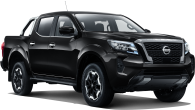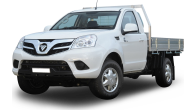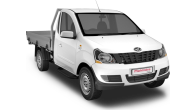In the realm of utes such as Toyota HiLux, Ford Ranger, Mazda BT-50 and the like, single-cab chassis models are the purest forms of real, purpose-built workhorses. These no-nonsense utes have been boiled down to the bare essentials: basic comfort, satisfactory safety, gutsy engine, tough cabin and functional tray.
In an attempt to keep pace with the modern-day ute mob, Isuzu updated its D-Max earlier this year with a torquier Euro5-compliant engine and a new transmission, as well as a new up-front design, but have these changes been enough to put the D-Max single-cab chassis firmly into the competitive wolf pack of work trucks?
Isuzu D-MAX 2018: SX Hi-Ride (4x4)
| Engine Type | Diesel Turbo 4, 3.0L |
|---|---|
| Fuel Type | Diesel |
| Fuel Efficiency | 7.8L/100km (combined) |
| Seating | 5 |
| Price From | $20,460 - $25,960 |
| Safety Rating |
|
Is there anything interesting about its design?
7 / 10
This is part of a refreshed model range, so its exterior has been tidied up and brought into the modern day. Its front end is now sleeker-looking than its predecessors', but the exterior retains that ute-specific boxy-strong shape, which is a good thing.
Its dimensions are 5040mm long, 1860mm wide (excluding door mirrors) and 1780mm high.
The interior is plain and simple, which is fine. The seats are flat, adequately cushioned and have hard-wearing cloth covers.
The SX has halogen multi-reflector headlights, gun-metal grey radiator grille, black door handles, colour-coded power door mirrors with integrated turn indicators, and, crucially for those who will use the ute for work, this D-Max has under-front steel plate skid/splash shield and steel-plate guards on its sump and transfer case.
.jpg)
Our heavy-duty aluminium tray had a built-in metal rear-window guard, rubber guards, and side steps – all handy additions to a tray that needs to be versatile enough to excel on building sites.
Our tester had a Splash White exterior paint job; there are seven other colour options, including Venetian Red mIca, Obsidian Grey mica, Tundra Green mica and more.
This D-Max is not a stunner by anyone's standards, but looking good has never been part of any job brief for a single-cab chassis ute.
How practical is the space inside?
7 / 10
Build quality is on the right side of impressive and while the interior is rather basic and the seats are flat and lack lumbar support and height adjustment (no surprise in a real ute), the cabin is comfortable enough for working people. This is not a long-distance outback tourer; it's made for short trips, across town for materials, and to and from job sites.
We drove this as a daily driver and its very basic interior proved to be easy to clean (the rubber floor mats are a bonus) and highly useable as a secondary work space or even mobile office.
Hard-plastic surfaces on the dash and doors, and durable cloth coverings on seats and head rests only fully reveal their true worth in something like this D-Max, copping everything from dirt and dust, to sand and mud, and anything else we inadvertently introduced to the interior.
I'm a big fan of "Jesus!" handles (or as Isuzu describes them: A-pillar assist-grips) and this SX has one each for driver and passenger.
All controls are large and easy to read, understand and operate, making changing channels, screen modes or aircon fan speed and temperature while on the move a simple task.
In the grand tradition of single-cab chassis models making few concessions to the maintenance or improvement of the driver's personal appearance, there are no vanity mirrors (any self-respecting tradie won't miss them), but, in line with its practical work-day application, this D-Max's wing mirrors are electrically adjustable.
When it comes time to find somewhere to throw all of your bits and pieces, you don't have a lot of choice in this thing, considering it's a single cab and there isn't a lot of storage space to play with anyway. First up, there are two glove boxes, one upper, one lower; the top one, the smaller one of the two, has a 12V power outlet; the bottom one is slightly bigger but a bit awkward to access and use.
As mentioned earlier, there is a pop-out cup-holder for driver and passenger near each side aircon vent, there are centre console spaces for two cups, and there is a hard-plastic bottle bulge in each door.
If the driver and/or passenger are short, there is some room freed up behind the seats for extra gear (tools etc), but not much.
For extra carrying capacity up top, a ladder rack, which extends from the very rear of the tray to the cab, is an option.
Does it represent good value for the price? What features does it come with?
7 / 10
As tested, our SX has a $40,100 price tag but that excludes the tray (in this instance, a heavy-duty aluminium unit; RRP$2586.10) and on-road costs.
There is a fair bit of gear squeezed into the single-cab chassis package, including keyless entry, aircon, an eight-inch full-colour touchscreen entertainment unit with four speakers, a USB, iPod input and Bluetooth audio streaming.
The SX's leather-wrapped steering wheel has controls for pretty much everything, including audio and cruise control.
There are pop-out cup-holders for driver and passenger in front of each side air vent, centre console spaces for two cups, and there's a decent-sized hard-plastic bottle pocket – or bottle bulge – in each door.
.jpg)
The D-Max has a raft of active and passive safety features, including six airbags, ESC, traction control, Hill Start Assist, Hill Descent Control, ABS with Electronic Brakeforce Distribution (EBD) and Emergency Brake Assist (EBA). A reversing camera is available as an option.
All Isuzus are covered by Service Plus 555: a five-year/130,000km warranty, five years roadside assistance, and five years/50,000km capped price servicing.
There is a range of Isuzu genuine accessories including chrome alloy bull bar, headlight protectors, snorkel, ladder rack kit (for the tray), tray tool box, and more.
What are the key stats for the engine and transmission?
7 / 10
This D-Max has a four-cylinder 3.0-litre turbo-diesel engine – producing 130kW at 3600 rpm and 430Nm at 1700-3500rpm – matched to a six-speed Rev-Tronic automatic transmission with sequential sport mode.
.jpg)
That combination is an effective one , and a real mouthful to say, but it's also quite an earful to cop while driving. The engine is a noisy unit under energetic use of the throttle and it doesn't help that the auto box scrambles up and down for the correct gear when under pressure. The same engine-and-transmission combination works better, more smoothly and with less resulting noise in the dual-cab D-Max.
Isuzu's 4X4 Terrain Command system – with 2H (2WD high range), 4H (4WD high range) and 4L (low range) on a dial – allows the driver to switch to a drive mode suited to the terrain, via a dial on the centre console.
How much fuel does it consume?
7 / 10
Fuel consumption is a claimed 7.7L/100km (combined). We recorded 9.8L/100km over more than 200km of mixed driving; mostly bitumen with some off-roading. It has a 76-litre fuel tank.
What's it like to drive?
7 / 10
This D-Max is 5040mm long (with a 3095mm wheelbase), 1860mm wide (excluding door mirrors) and 1780mm high. Its kerb weight is listed as 1736kg but that will vary according to which tray is fitted: economy alloy, general purpose alloy or heavy-duty alloy. As mentioned above, there are also ladder rack kits available.
Overall, the driving experience in this D-Max is a basic but enjoyable one. The steering wheel is only height-adjustable, not reach, but steering is otherwise generally fine, although there is a touch of understeer on sharper turns.
The impressively gutsy 3.0-litre engine has a real trade-off – it's noisy when pushed, and it lacks initial urge, making cutting into traffic from a standstill a sometimes nail-biting experience.
The six-speed auto transmission is an easier drive in manual mode, where it's not holding onto gears or grabbing them too soon, or too energetically.
Our SX had coil springs at the front, and heavy-duty leaf springs at the rear. Ride is firm and reasonably well settled, even without any load in the tray. It can, however, be quite jittery over harsher surfaces and really thumps through surprises potholes.
We took it off-road – nothing too hectic – and it coped easily on a route that included gravel tracks, patches of firm coastal sand and a couple of very shallow water crossings.
Rubber was Bridgestone Dueler A/T 245/70/R16 on steel rims and provided adequate grip. The SX has a full-sized spare, mounted under the tray.
We did a couple of "Watch out for that kangaroo!" surprise stops on bitumen and gravel and the D-Max's heavy-duty brakes – 300mm discs at the front and 295mm drums at the rear – pulled us up sharply.
The genuine Isuzu accessory heavy duty aluminium tray (RRP$2586.10, excludes fitment) fitted to our tester is 2550mm long (internal measure), 1842mm wide (external) and weighs 174kg.
Towing capacity is a claimed 3500kg (braked) on the spec sheet. Unbraked towing capacity is 750kg. Maximum towball download is 350kg, when the ute is fitted with a genuine Isuzu UTE tow kit. Payload is 1214kg. Gross combination mass is 5950kg.
The D-Max has 225mm ground clearance, 12.6m turning circle, and approach/departure/ramp-over angles of 29.4°/27.4° and 21.7° respectively. We took it off-road – nothing too hectic – and it coped easily on a route that included gravel tracks, patches of firm coastal sand and a couple of very shallow water crossings.
Warranty & Safety Rating
What safety equipment is fitted? What safety rating?
6 / 10
This D-Max has a four-star ANCAP rating. It has six airbags – dual front, curtain and side - and passive and active safety tech including ABS, EBD, EBA, hill start assist, hill descent control and more. A reversing camera is an option, not standard, in SX variants but our tester did not have one, which I was reminded of whenever I put the D-Max into reverse because a ‘rear camera not connected' warning appeared on the touchscreen every time.
What does it cost to own? What warranty is offered?
7 / 10
This D-Max has a five-year/130,000km warranty. Capped-price servicing is applied for the first five scheduled services, at 12-month or 10,000km intervals, and will set you back a total of $1500 (TBC).
Verdict
In a market awash with car-like utes, this single-cab chassis D-Max is an old-school utility vehicle with a fresh attitude, but it comfortably remains more of a purpose-built workhorse than a mixed-duty vehicle. It is basic, solid, reliable and highly functional, but it's also hard-riding and noisy. Its lack of a reversing camera as standard counts against it as well.
If you can cope with the few negatives – I can, no worries – then driving this D-Max as a very effective work truck is not going g to be a big ask for anyone serious about using a ute for what it's actually intended for.
What do you reckon – would you drive this D-Max as a dedicated work truck? Tell us what you think in the comments below.
Pricing Guides
.png)





.jpg)
.jpg)
.jpg)
.jpg)
.jpg)
.jpg)

.jpg)
.jpg)
.jpg)
.jpg)
.jpg)
.jpg)
.jpg)
.jpg)
.jpg)
.jpg)













.jpg)
